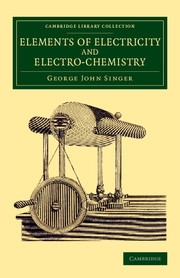
- Publisher:
- Cambridge University Press
- Online publication date:
- June 2015
- Print publication year:
- 2015
- First published in:
- 1814
- Online ISBN:
- 9781316015285

The amateur scientist George John Singer (1786–1817) worked in the family business of artificial flower and feather making, but all his spare time was absorbed in the study of electricity and electromagnetism. He invented his own apparatus, including a gold-leaf electrometer, and built a laboratory-cum-lecture room at the back of his house: his public demonstrations were attended by Faraday and Francis Ronalds, and he was also a friend of the pioneering 'electrician' Andrew Crosse. This significant book, published in 1814, demonstrates the breadth of Singer's knowledge of his subject and of other contemporary work in the field. It describes in detail electric phenomena, in nature and in the laboratory, covering a wide range of experiments with and applications of electricity, and discussing the work of Franklin, Volta, Crosse and Dalton, among others. Sadly, Singer's promising scientific career was brought to an early end by tuberculosis: he died aged only thirty-one.
 Loading metrics...
Loading metrics...
* Views captured on Cambridge Core between #date#. This data will be updated every 24 hours.
Usage data cannot currently be displayed.